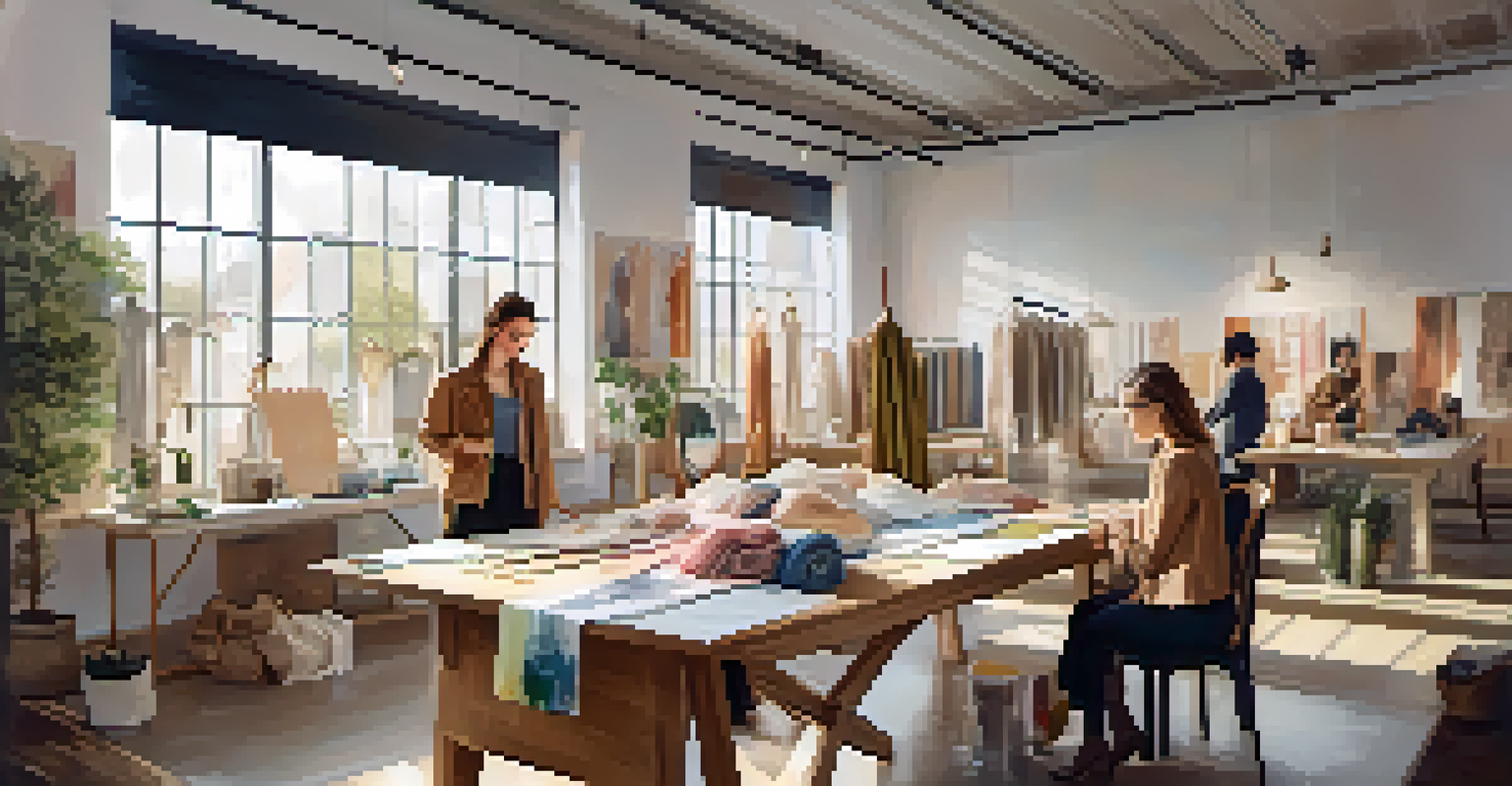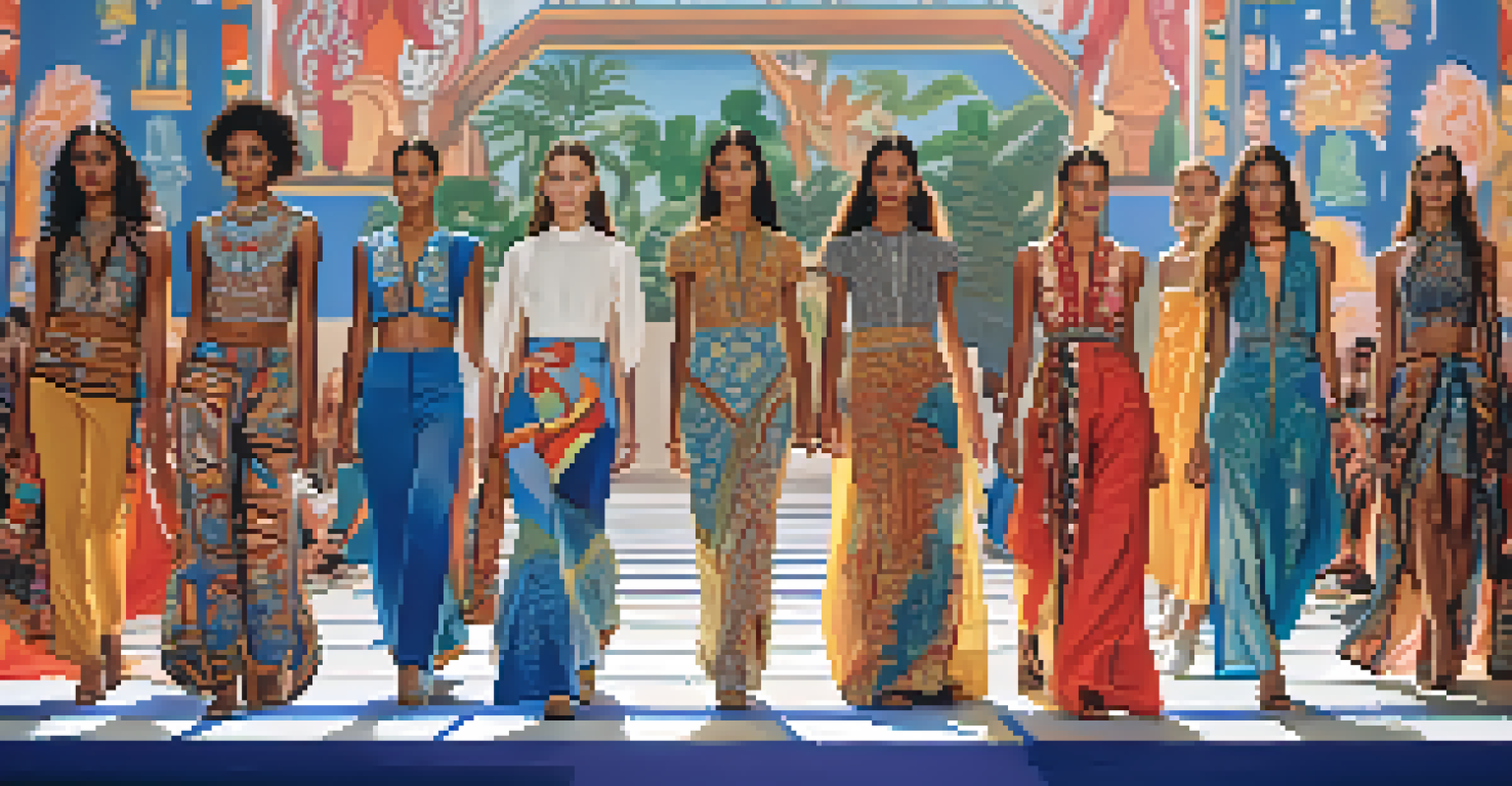How Personal Stories Influence Fashion Design Choices Today

Personal Narratives as a Source of Inspiration
Personal stories are often the heartbeat of fashion design, providing rich narratives that designers draw upon for inspiration. For instance, a designer may create a collection based on their childhood experiences, infusing vibrant colors and playful patterns that reflect those memories. These narratives allow designers to connect with their audience on a deeper level, evoking emotions that resonate with consumers.
Fashion is the armor to survive the reality of everyday life.
Moreover, these stories can highlight cultural heritage, with designers often incorporating traditional elements to celebrate their roots. This not only enriches the fashion landscape but also educates consumers about diverse cultures. By sharing personal stories through their designs, creators invite others to appreciate the beauty of different experiences.
Ultimately, personal narratives in fashion create a unique blend of artistry and authenticity. When consumers wear these pieces, they carry a part of that story, making the clothing feel more meaningful. This connection helps to foster brand loyalty and a sense of community among wearers.
Fashion as a Medium for Self-Expression
Fashion has always been a powerful medium for self-expression, allowing individuals to showcase their personalities and stories. Designers today harness this power, crafting pieces that encourage wearers to express their unique narratives. For example, oversized silhouettes and bold prints may symbolize a rebellious spirit, while minimalist designs could reflect a more introspective mindset.

This trend has led to an increase in custom and personalized clothing options, where consumers can collaborate with designers to create pieces that truly reflect their identities. Such collaborations can result in one-of-a-kind garments that tell a story, whether it's a significant life event or a cherished memory. The process of co-creating these pieces fosters a deeper connection between the designer and the wearer.
Fashion Tells Personal Stories
Designers draw inspiration from their personal narratives, creating collections that resonate emotionally with consumers.
Furthermore, social media plays a crucial role in this self-expression journey, as people share their personal stories through fashion online. Influencers and everyday individuals alike are showcasing their outfits, often accompanied by anecdotes that highlight their significance. This not only inspires others but also reinforces the idea that fashion is a personal narrative waiting to be told.
Cultural Influences and Personal Backgrounds
Cultural backgrounds heavily influence fashion design, as designers often weave their heritage into their creations. This is particularly evident in collections that celebrate specific traditions, using fabrics, colors, and patterns that have historical significance. For instance, a designer of African descent might incorporate traditional prints, telling stories of ancestry through modern silhouettes.
Style is a way to say who you are without having to speak.
These cultural influences not only enrich the designer's portfolio but also promote diversity within the fashion industry. As consumers increasingly seek authenticity, collections that reflect personal and cultural narratives often resonate more. They invite wearers to explore their own identities while appreciating the stories behind each piece.
Additionally, as global connectivity increases, designers are exposed to a myriad of cultural influences. This fusion of styles can lead to innovative designs that celebrate multiple narratives, reflecting the interconnectedness of our world. The result is a fashion landscape that honors personal stories while embracing diversity.
The Role of Sustainability and Ethical Fashion
In recent years, sustainability has become a significant consideration in fashion design, often influenced by personal stories and values. Many designers are driven by their experiences with environmental issues, leading them to create collections that prioritize eco-friendly materials and ethical production practices. This shift reflects a growing awareness of the impact fashion has on the planet.
For instance, a designer who has witnessed the effects of pollution in their hometown may choose to use recycled materials in their clothing. Such decisions not only tell a personal story but also align with the increasing consumer demand for sustainable practices. By sharing these narratives, designers can inspire others to make conscious choices about their fashion consumption.
Self-Expression Through Clothing
Fashion serves as a powerful medium for individuals to express their unique identities and personal experiences.
Moreover, ethical fashion encourages transparency in the supply chain, allowing consumers to connect with the stories behind the garments they wear. As people become more informed about the origins of their clothing, they often seek out brands that align with their values. This creates a powerful cycle where personal stories drive sustainable practices, ultimately leading to a more responsible fashion industry.
Fashion and Mental Health Awareness
Mental health awareness has emerged as a significant theme in contemporary fashion, with many designers using their platforms to share personal struggles and stories. This approach not only fosters dialogue about mental health but also normalizes the conversation around it. For example, a designer might create a collection inspired by their journey with anxiety, using colors and styles that evoke a sense of calm.
These narratives resonate with consumers who may have had similar experiences, allowing them to feel seen and understood through fashion. The garments become more than just clothing; they transform into symbols of hope and resilience. By wearing these pieces, individuals can express their own journeys while supporting a cause that is deeply personal to the designer.
Furthermore, fashion shows and campaigns that focus on mental health can create a community of support, encouraging others to share their stories. This movement highlights the power of fashion not only as a form of expression but also as a tool for advocacy. As the industry continues to embrace mental health narratives, it paves the way for greater understanding and acceptance.
The Impact of Social Media on Fashion Narratives
Social media has revolutionized the way personal stories influence fashion design, providing a platform for designers to share their journeys. Through platforms like Instagram, designers can showcase their creative processes, allowing followers to connect with their narratives. This transparency fosters a sense of community and encourages audience engagement, as people feel more invested in the stories behind the designs.
Moreover, social media has democratized fashion, enabling emerging designers to share their personal stories without the constraints of traditional media. By using hashtags and platforms, they can reach wider audiences, creating movements around their narratives. This shift has led to a more diverse representation in fashion, where personal experiences are celebrated and amplified.
Community Built on Shared Experiences
Fashion fosters a sense of belonging by uniting individuals through shared stories and collective identities.
Additionally, consumers are now active participants in shaping fashion narratives, sharing their own stories and influencing trends. This reciprocal relationship between designers and consumers enriches the fashion landscape, creating a vibrant tapestry of personal experiences. As social media continues to evolve, so too will the ways in which personal stories shape the future of fashion.
Building Community Through Shared Experiences
Fashion is increasingly becoming a vehicle for building community, as shared personal stories bring people together. Designers often create collections that resonate with specific groups, whether based on shared interests, experiences, or challenges. This sense of belonging can be especially powerful in niche markets, where individuals seek connection through fashion.
For example, designers may create lines that cater to specific body types or celebrate unique identities, fostering inclusivity. These collections not only empower individuals but also create a sense of camaraderie among wearers, uniting them through shared experiences. When consumers wear these designs, they are not just making a fashion statement; they are participating in a larger narrative.

Furthermore, community-building extends beyond the clothing itself, as events and collaborations emerge around shared stories. Fashion shows, workshops, and pop-up events often bring together individuals who share similar journeys, creating spaces for dialogue and support. This communal aspect of fashion enriches the experience, transforming it into a celebration of personal narratives and collective identity.